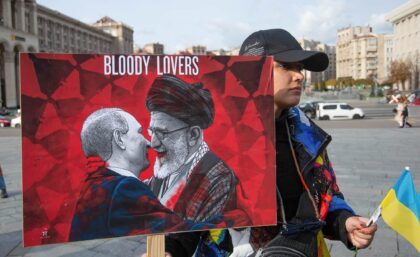Russia and Iran: A Confederacy of Rogues

Photo: An Iranian woman who lives in Ukraine, holds a placard with the likenesses of Russian President Vladimir Putin and Iranian Supreme Leader Ali Khamenei during a protest against Iran’s government and deliveries of Iranian drones to Russia in central Kyiv. Credit: Oleksii Chumachenko / SOPA Images/Sipa USA
In the over-excited language of state-run propagandists, the West is beginning to tremble at the emergence of a fearsome new Russo-Iranian axis that promises to multiply their joint strengths and ruthlessly exploit weaknesses in the liberal democratic order.
Well, perhaps.
There are certainly things to be concerned about, especially on the security and sanctions fronts. On March 8, Sky News released an investigation into the delivery of a large batch of ammunition from Iran to Russia. According to the broadcaster, approximately 100 million bullets and around 300,000 shells for the Russian armed forces were transported across the Caspian Sea in January. According to a Sky News security source, the ammunition was intended for machine guns and rifles, as well as rocket launchers and mortars. In addition, the cargo included helmets and body armor.
There is more. On March 11, Iranian state media reported an agreement to buy advanced Su-35 combat aircraft. The decision, not yet confirmed by the Kremlin, would be a significant development in the region given the Iranian air forces’ current, antiquated inventory. It is thought the sale would be a quid pro quo for Iranian military aid to Russia, which has included suicide drones used to attack Ukraine’s energy infrastructure.
Cooperation has also extended to space, with Russian launching an Iranian satellite in September, which caused US concern that this would give the regime and its militia allies across the Middle East a significant new capability.
None of this should come as a surprise. Back in December, US National Security Council coordinator, John Kirby, said that relations between Russia and Iran have strengthened into a full-fledged defense partnership, which can be regarded as a global threat. The two countries are now providing each other with unprecedented military support and are also considering the possibility of joint production of combat drones. Naval vessel cooperation and other defense programs are also under consideration.
In fact, the rapprochement of the two regimes began even before Russia’s full-scale invasion of Ukraine. After the assassination in a US airstrike of Iranian Revolutionary Guard Corps (IRGC) General Qasem Soleimani in January 2020, the Russian Foreign Ministry erupted with angry statements, saying, “this US step lies outside any legal framework.”
Russian Orthodox radicals from the Tsargrad TV channel, which echo government themes, proclaimed Soleimani and his militants were heroes fighting, “servants of the coming Antichrist – the occupiers of the Holy Land and their overseas curators.” Soleimani has been praised by the Russian military for his effective hybrid war against the United States in Iraq, as well as for nurturing Hezbollah and saving Bashar al-Assad’s regime in Syria.
So the roots of the relationship already existed, but they have been boosted by the all-out war and the huge slew of sanctions imposed on Russia (the two countries are the world’s most-sanctioned states.)
In early March, experts from one of Russia’s most influential think tanks, the Valdai Club, published an article on “Russian-Iranian relations under new conditions.” It noted intensifying cooperation in the energy and oil and gas sectors.
In particular, this involved the development of Iranian oil and gas fields, building gas pipelines, implementing liquefied natural gas (LNG) projects, and dealing in natural gas. In addition, the article says that the allies are studying plans to create joint ventures in the field of mechanical engineering and aircraft building, as well as shipbuilding, railway transport, and pharmaceuticals.
These are not chosen at random; they are Russia’s most sanctions-hit industries. One of the most famous state media outlets in Russia, Izvestia newspaper, admitted that Russian auto factories produced 64.2% fewer cars from January to August than in the corresponding period of 2021. The output of trucks decreased by 20.1%, minibuses by 41.9%, and buses by 10.2%. The publication noted that in early spring, production at vehicle plants inside Russia, including those of Volkswagen, Skoda, Nissan, Toyota, Hyundai, BMW, Ford, and many others, was suspended. Most remain idle.
Vladimir Putin’s Russia is especially fascinated by how Iran has evaded and continued to live under sanctions. Russia’s leading publications have printed articles about how its friend has survived for decades under sanctions, with comments on how its experience can be used in Russia. Special attention has focused on the use of shell companies.
Energy cooperation has been intensified. In early 2022, Russia provided a $1.4bn credit line for the construction of a thermal power plant in Iran. In July, Gazprom and the Iranian National Oil Corporation signed a memorandum of understanding and cooperation, which resulted in the development of projects estimated at $40bn.
Russian media say the Kremlin is particularly interested in transporting hydrocarbons to Iran through Azerbaijan and from there to the markets of the Asia-Pacific region.
So far, so good from the Russo-Iranian viewpoint. But there are some major buts.